Sharks are among the most dangerous species on our planet, often referred to as the ocean’s assassins.
The Most Dangerous Shark Species in the Ocean
1. Great White Shark
Also known by various names such as white pointer, white death, or simply great white, this species belongs to the Lamnidae family and is found in coastal waters across all oceans. Great white sharks are famous for their size, reaching lengths of up to 6.4 meters.
This species is typically found in coastal regions around the globe. Weighing over 2 tons, the great white shark is the largest predatory fish in the world. They are also considered apex predators, threatened only by humans and orcas (there have been cases of adult great whites being preyed upon by orcas).
Due to their teeth being crucial hunting tools, great white sharks can replace their teeth multiple times. Their teeth can be replaced indefinitely throughout their lives. As soon as a tooth is broken or damaged, a new one can replace it in a very short time, even within 24 hours. This characteristic ensures that sharks always have sharp, healthy teeth, which guarantees successful hunts.
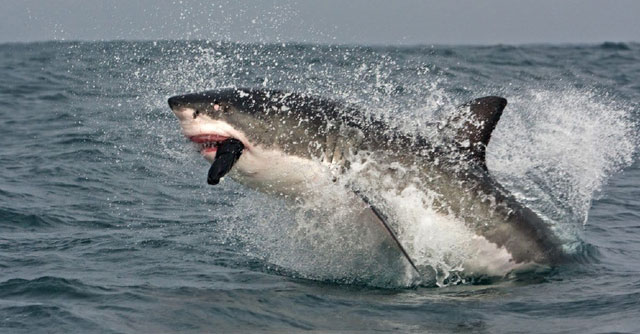
According to incomplete statistics, among 100 shark attacks on humans worldwide each year, 1/3 to 1/2 are caused by great white sharks. In fact, when great whites are hunting, it is very difficult to distinguish between a surfer and a seal, which can lead to accidental attacks on humans. They are aggressive marine predators and can swim at speeds of 40 km/h. Their main prey includes turtles, seals, dolphins, and more.
2. Tiger Shark
The tiger shark, also known as the leopard shark, is the only species in the genus Galeocerdo, family Carcharhinidae. This species thrives in tropical and temperate ocean waters worldwide, especially around central Pacific islands. They seem to eat everything, including humans.
Sometimes, human waste such as license plates or pieces of old tires are found in their digestive systems. This species is notoriously dangerous for attacking swimmers, divers, and surfers in Hawaii; they are often referred to as “the menace of Hawaiian surfers” and “the garbage can of the sea.”
A study once found remains of goats, horses, and even metal waste in the stomachs of tiger sharks.
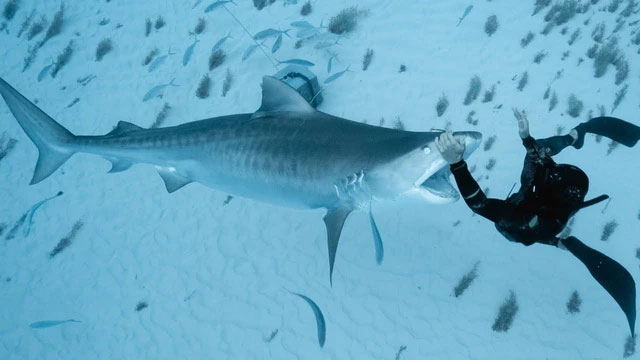 The name of the tiger shark comes from the black stripes on its body during its juvenile stage, although these stripes fade with age. This shark can grow over 4 meters long, with females being slightly larger than males. The maximum weight of a female tiger shark can reach up to 900 kg. This species ranks second after the great white shark for human attacks. Tiger sharks primarily hunt at night and are also referred to as “the garbage can of the sea.”
The name of the tiger shark comes from the black stripes on its body during its juvenile stage, although these stripes fade with age. This shark can grow over 4 meters long, with females being slightly larger than males. The maximum weight of a female tiger shark can reach up to 900 kg. This species ranks second after the great white shark for human attacks. Tiger sharks primarily hunt at night and are also referred to as “the garbage can of the sea.”
3. Bull Shark
The bull shark is a widely distributed shark species, considered one of the most primitive among all shark types due to their less evolved skeleton compared to other sharks.
They inhabit warm, shallow waters along coastlines and rivers, favoring shallow areas and often found in brackish or freshwater environments, such as river mouths and large rivers. They can survive in both saltwater and freshwater and can even live deep inland in rivers. Bull sharks are known for their aggressive nature.
Despite being able to exist in rivers, bull sharks are not truly freshwater fish.
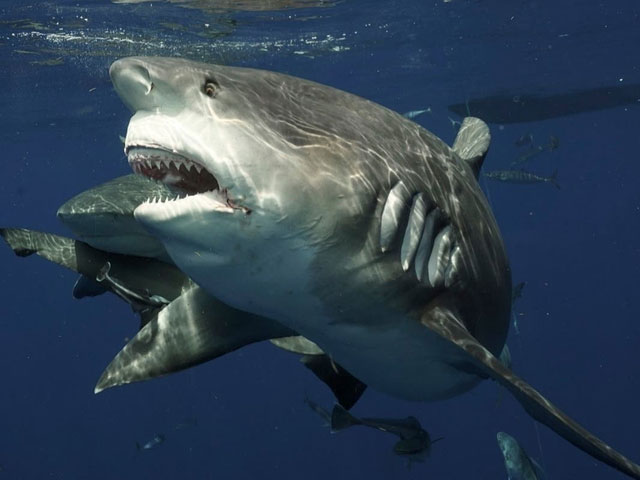
Bull sharks are commonly found along the eastern coast of the United States and the Gulf of Mexico, and they are extremely aggressive, sometimes swimming into freshwater areas near the coast, making them more accessible to humans. Adult bull sharks have no natural predators; they are carnivorous, with their main diet consisting of fish, other sharks, turtles, seabirds, rays, dolphins, and more.
4. Blacktip Shark
This species typically inhabits bays, coral reefs, and shallow waters, at depths of 20–75 meters. Blacktip sharks can reach a maximum size of about 4 meters and weigh around 30 kg; newborn pups weigh about 0.7 kg and are approximately 35 cm long. Their primary diet consists of small fish, shrimp, crabs, and sea snakes.
Blacktip sharks have a very small range of habitat and show long-term site fidelity, often residing in the same area for many years. They are active predators, hunting small bony fish, cephalopods, and crustaceans, but they also prey on sea snakes and seabirds. Descriptions of blacktip shark behavior are generally variable and sometimes contradictory, partly reflecting geographical differences within the species’ range.
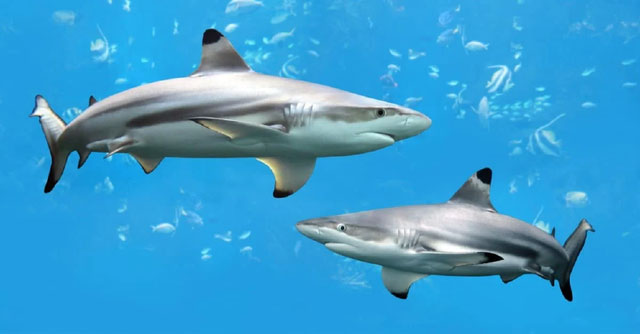
Blacktip sharks are found in the Gulf of Mexico year-round and are also one of the shark species that often leap out of the water while hunting. When threatened, they will charge directly at the threat or suddenly roll from side to side, preparing for a secondary attack at any moment. Blacktip sharks do not pose a significant threat to humans, and although the U.S. has recorded over 40 incidents of human attacks, there have been no reported fatalities.
5. Sand Shark
The sand shark, or brown shark, is a subspecies of the requiem shark in the Carcharhinidae family, originating from the Atlantic and Indian-Pacific Oceans. They are among the largest coastal sharks in the world, distinguished by their large triangular dorsal fin and brown coloration.
True to their name, they are found at the sandy bottom of shallow coastal waters in bays, river mouths, and ports, but they also swim in deeper waters over 200 meters. Sand sharks are found from tropical to temperate seas worldwide, along the Atlantic coast from North America to South America.
Juveniles are commonly found in shallow waters like Chesapeake Bay, ranging from Delaware Bay to South Carolina. Other breeding areas for sand sharks include Boncuk Bay in Marmaris, Turkey.
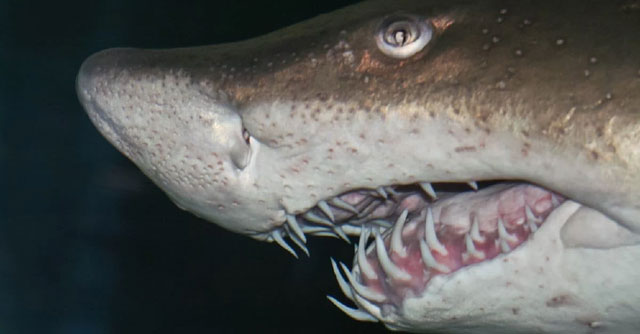
Sand sharks are often seen near the sea floor, and sometimes in shallow waters, where they can be spotted by surfers. Sand sharks have a unique hunting behavior; they breathe from the surface, increasing their buoyancy, allowing them to lie almost completely still and approach prey undetected. Although humans are not their typical prey, U.S. statistics show that sand sharks have attacked over 30 people, with no fatalities reported.
6. Hammerhead Shark
This shark species is named for its uniquely shaped head. Hammerhead sharks have two eyes placed on either side of their “cephalofoil” – the hammer – allowing them to see both above and below simultaneously. Hammerhead sharks are highly agile and can swim at high speeds. This species often swims in schools during the day, exhibiting a strict social hierarchy within the group.

There are 9 species of hammerhead sharks on Earth, the largest being the great hammerhead, known for its small mouth and eyes on either side of its head. Hammerhead sharks have fewer natural predators and are rarely killed by other marine creatures when mature, although orcas remain one of the threats to their survival. There have been previous instances of hammerhead sharks attacking humans, but they are not fatal; instead, they often just show curiosity towards divers.
7. Shortfin Mako Shark
The shortfin mako shark is a large shark species in the Lamnidae family. It, along with its close relative the longfin mako, is collectively referred to as mako sharks. Shortfin mako sharks are found in temperate and tropical seas worldwide.
Aside from some individuals reaching swimming speeds of up to 74 km/h, they can also leap out of the water up to 6 meters high.
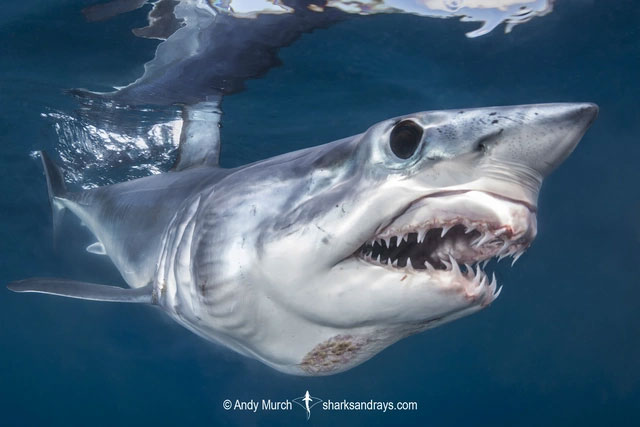
This is one of the most dangerous shark species in the ocean, with a bite force that ranks among the strongest in sharks, reaching up to 610 kg, making it so that most prey have little chance of escaping when pursued. Reports indicate that there have been 9 recorded incidents of shortfin mako shark attacks on humans, one of which resulted in a fatality.


















































